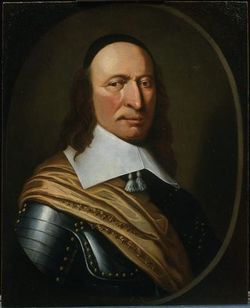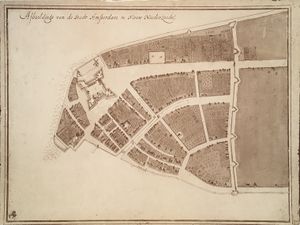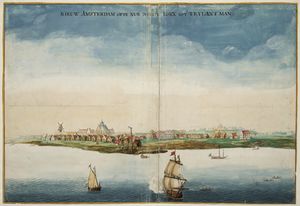پيتر ستايڤسانت
| پيتر ستايڤسانت Peter Stuyvesant | |
|---|---|

| |
| رسم لهندريك كوتوريه ح. 1660 | |
| 7th مدير-جنرال هولندا الجديدة | |
| في المنصب 1647–1664 | |
| سبقه | وليام كيفت |
| خلفه | إلغاء المنصب |
| تفاصيل شخصية | |
| وُلِد | ح.1612 پپرگا، الجمهورية الهولندية |
| توفي | أغسطس 1672 (عمره ه. 60) نيويورك، مقاطعة نيويورك |
پيتر ستايڤسانت Peter Stuyvesant (ح.1612 - أغسطس 1672)، كان آخر مدير-جنرال هولندي لمستعمرة من 1647 حتى التنازل عنه مؤقتاً لإنگلترة عام 1664، بعدها أعيد تسميتها بنيويورك. كان ستايڤسانت شخصية بارزة في التاريخ المبكر لمدينة نيويورك.
تضمنت إنجازات ستايڤسانت كمدير-جنرال التوسع الكبير لمستوطنة نيو أمستردام فيما وراء الحافة الجنوبية لمنهاتن. من خلال مشروعات بنيت تحت ادارة ستايڤسانت تم بناء سور واقي في وال ستريت، القناة التي أصبحت فيما بعد برود ستريت، وبرودواي.
. . . . . . . . . . . . . . . . . . . . . . . . . . . . . . . . . . . . . . . . . . . . . . . . . . . . . . . . . . . . . . . . . . . . . . . . . . . . . . . . . . . . . . . . . . . . . . . . . . . . . . . . . . . . . . . . . . . . . . . . . . . . . . . . . . . . . . . . . . . . . . . . . . . . . . . . . . . . . . . . . . . . . . . .
حياته وعمله
| سلسلة هولندا الجديدة |
|---|
| الاستكشاف |
| تحصينات جديدة |
| المستوطنات: |
| نظام پاترون |
|
| شخصيات |
| احتجاج فلشنگ |
وُلد ستايڤسانت في پپرگا، هولند، لوالده الوزير بالثازر يوهانس ستايڤسانت، وزير، ومرگريتا هاردنشتاين حوالي 1612. نشأ في شرپنزيل. درس اللغات والفلسفة في فرانكر،[1] وانضم إلى شركة الهند الغربية الهولندية قبل عام 1630، حيث تولى منصب مدير مستعمرة كوراساو من 1642 إلى 1644.
في أبريل 1644، قام بالهجوم على جزيرة سانت مارتن وكانت تحت الادارة الإسپانية وفقد في هذا الهجوم الجزء السفلي من ساقه اليمنى بعد إصابته بقذيفة مدفع. رجع إلى هولندا، حيث استبدلت ساقه بأخرى خشبية. ربما كان هذا سبباً في حمله الاسم المستعار "الساق الفضية القديمة" لأنه كان يستخدم عصا خشبية مطلية بالفضة كساق اصطناعية.[2]

في مايو 1645 اختارته شركة الهند الغربية الهولندية ليخلف وليام كيفت كمدير-جنرال لمستعمرة هولندا الجديدة. وصل إلى نيو أمستردام في 11 مايو 1647. في سبتمبر 1647، وعُين مستشار لمجلس الرجال العشر الممثلين للاستعماريين.
تزوج جوديث بايارد (ح. 1610-1687) عام 1645. بايارد وُلدت في بردا، وكانت شقيقة صمويل بايارد من أمستردام، الذي تزوج من آنا ستايڤسانت، شقيقة ستايڤسانت. وكانت تمرضه بعد فقده لساقه اليمنى في سانت مارتين وبعد عودته لهولندا في فترة النقاهة. أنجب پترس وجوديث ولد، نيكوليس وليام ستايڤسانت (1648–1698)، الذي تزوج من ماريا بيكمان، ابنة وليام بيكمان.
دخل ستايڤسانت في نزاع مع ثيوفيلس إيتون، حاكم مستعمرة نيو هيڤن، على الحدود بين المستعمرتين. عام 1648، بدأ النزاع بينه وبين برانت أيرلتز ڤان سلختينهورست، وكيل پاترونية (ملتزمية) رنسليرويك. ادعى ستايڤسانت أنه يملك السلطة على رنسليرويك على الرغم من الامتيازات الممنوحة لكاليان ڤان رنسلير في عام 1629.
في 1649، انتقل ستايڤسانت إلى فورت اورانج وبرفقته قوة عسكرية وأمر بازالة المنازل الموجودة لضمان أفضل دفاع عن الحصن في حالة وقوع هجوم من الأمريكان الأصليين. عندما رفض ڤان سلختينهورست، أرسل ستايڤسانت مجموعة جنود لتنفيذ أوامره بالقوة. الجدل الذي جاء في أعقاب تأسيس بفڤرويك.
في سبتمبر 1650، عقد لقاء مع المفوضين على الحدود في هارتفورد، كونتيكت. كانت الحدود مرسمة على غير موافقة الرجال العشرة، الذين أعلنو أن "الحاكم قد تنازل عن أراضي كافية لتأسيس خمسين مستعمرة كل خمسين ميل مربع". بعدها هدد ستايڤسانت بحل المجلس. تم رسم خطة جديدة للحكومة المحلية في هولندا، وحملت اسم "نيو أمستردام" وأعلنت رسمياً في 2 فبراير 1653. ألقى ستايڤسانت خطاب بهذه المناسبة، وقال أن سلطته لا تزال كما هيا".
أُمر ستايڤسانت بالعودة إلى هولندا، لكن سرعان ما تم إلغاء الأمر تحت ضغط ولايات هولندا ومدينة أمستردام. استعد ستايڤسانت للهجوم بعد إعطاءه أوامر للمواطنين بحفر خندق من نهر الشمال إلى نهر الشرق والبدء في بناء حصن.
عام 1653، عقدت اتفاقية بين نائبين من كل قرية في هولندا الجديدة للمطالبة باصلاحات، وأمر ستايڤسانت بحل هذا المجلس، قائلاً: "حصلنا على سلطتنا من الرب ومن الشركة، ليس من موضوعات قليلة متجاهلة".
في 1655، أبحر إلى نهر دلاوير على رأس أسطول من سبع سفن وحوالي 700 رجل واستولى على مستعمرة السويد الجديدة، والتي أعيد تسميتها ب"نيو أمستل". في غيابه، تعرض نيو أمستردام إلى الهجوم من قبل الأمريكان الأصليين، أثناء "حرب الخوخ".
في عام 1657، لم يسمح ستايڤسانت بالحرية الدينية الكاملة في المستعمرة،[3] وخاصة في حضور جمعية الأصدقاء الدينية، وأمر بتعذيب روبرت هودجسون أمام العامة، وكان شاب في ال23 انضم إلى الجمعية وأصبح واعظاً مؤثراً. ثم أصدر ستايڤسانت مرسوماً، يعاقـَب مخالفه بالغرامة والحبس، ضد أي شخص تثبت ادانته بإيواء الكويكرز. وقد أدى هذا الفعل إلى احتجاج أهالي فلشنگ، كوينز، فيما سُمي لاحقاً احتجاج فلشنگ، الذي يعتبر البعض سابق ممهد للفقرة في دستور الولايات المتحدة حول حرية الديانة في وثيقة الحقوق الأمريكية. Freedom of religion was also tested when Peter Stuyvesant refused to allow Jews from Northern Brazil to settle permanently in New Amsterdam (without passports) and join the existing community of Jews (with passports from Amsterdam). Stuyvesant's decision was rescinded after pressure from the directors of the Dutch West India Company; as a result, Stuyvesant allowed Jewish immigrants to stay in the colony as long as their community was self-supporting, but - with the support of the company - forbade them to build a synagogue, forcing them to worship in a private house.[4] This followed earlier efforts to have Jews required "in a friendly way to depart" the colony. As he wrote to the Amsterdam Chamber of the Dutch West India Company in 1654 he hoped that "the deceitful race, - such hateful enemies and blasphemers of the name of Christ, - be not allowed to further infect and trouble this new colony."[5]
في 1664، تنازل تشارلز الثاني من إنگلترة عن العرش لشقيقه، جيمس الثاني من إنگلترة، a large tract of land that included هولندا الجديدة. Four English ships bearing 450 men, commanded by Richard Nicolls, seized the Dutch colony. On 30 August 1664, George Cartwright sent the governor a letter demanding surrender. He promised "life, estate, and liberty to all who would submit to the king's authority." Stuyvesant signed a treaty at his Bouwerij house on 9 September 1664. Nicolls was declared governor, and the city was renamed New York City. Stuyvesant obtained civil rights and freedom of religion in the Articles of Capitulation. The Dutch settlers mainly belonged to the Dutch Reformed church, a strict Calvinist denomination. The English were Anglican, theologically closer to the Roman Catholic Church.
في 1665، ذهب ستايڤسانت إلى هولندا لتقديم تقرير عن فترة حكمه. في عودته، قضى باقي حياته في مزرعة خارج المدينة، تسمى بويري العظمى، وكان يقع خلفها غابات ومستنقعات قرية هارلم . A pear tree that he reputedly brought from the Netherlands in 1647 remained at the corner of Thirteenth Street and Third Avenue until 1867, bearing fruit almost to the last. The house was destroyed by fire in 1777. He also built an executive mansion of stone called Whitehall. He died in August 1672 and his body was entombed in the east wall of St. Mark's Church in-the-Bowery, which sits on the site of Stuyvesant’s family chapel.[6]

عهده
- Stuyvesant and his family were large land owners in the northeastern portion of New Amsterdam, and the Stuyvesant name is currently associated with the Stuyvesant Town housing complex as well as Stuyvesant Square, a park in the area. His farm, called the "Bouwerij" - the seventeenth-century Dutch word for farm - was the source for the name of the Manhattan street The Bowery, and the chapel facing Bouwerie's long approach road (now Stuyvesant Street) became St. Mark's Church in-the-Bowery. The contemporary neighborhood of Bedford-Stuyvesant, Brooklyn includes Stuyvesant Heights and retains its name. Also named after him are the hamlets of Stuyvesant and Stuyvesant Falls in Columbia County, New York, where descendants of the early Dutch settlers still live and where the Dutch Reformed Church remains an important part of the community, as well as shopping centers, yacht clubs and other buildings and facilities throughout the area where the Dutch colony once was. More modestly, Peter Island in the British Virgin Islands was also named after Stuyvesant during the Dutch West India Company's administration of that Territory.
- Stuyvesant was a great believer in education. In 1660 he was quoted as saying that "Nothing is of greater importance than the early instruction of youth." In 1661, New Amsterdam had one grammar school, two free elementary schools, and had licensed 28 masters of school. To honor Stuyvesant's dedication to education and New Amsterdam's legal-cultural tradition of toleration under Stuyvesant, Stuyvesant High School in Manhattan was named after him.
- The last direct descendant of Pieter Stuyvesant to bear his surname was Augustus van Horne Stuyvesant, Jr., who died a bachelor in 1953 at the age of 83 in his mansion at 2 East 79th Street. Rutherford Stuyvesant, the 19th century New York developer, and his descendants are also descended from Pieter Stuyvesant, however Rutherford Stuyvesant changed his name from Stuyvesant Rutherford in 1863 to satisfy the terms of a will.[7]

في الثقافة العامة
- Peter Stuyvesant is the major antagonist in the 1938 Kurt Weill-Maxwell Anderson musical Knickerbocker Holiday, in which he sings the song "September Song". In the stage production he was portrayed by Walter Huston; in the much-altered 1944 film version he was portrayed by Charles Coburn in his only singing role.
- In Sid Meier's Civilization IV: Colonization, Peter Stuyvesant is one of the leaders of the Dutch colonies. Adriaen van der Donck is the other possible Dutch leader. In Sid Meier's Colonization computer game, Stuyvesant can be elected to the Continental Congress, allowing the player to build Custom Houses which automate trade with the mother country.
- Stuyvesant was a key figure in the Belgian comic strip Suske en Wiske in episode 269, "De Stugge Stuyvesant".
- The old time radio show Duffy's Tavern had an episode which used a newly discovered diary of Stuyvesant as a plot device.
- A cigarette brand by Imperial Tobacco is named Peter Stuyvesant. These cigarettes are popular in Australia, Greece, New Zealand, Zambia and South Africa.
- In Charles Bukowski's 1978 novel Women, the main character, Henry Chinaski, vomits on Peter Stuyvesant's burial vault cover before a poetry reading at St. Mark's Church.
انظر أيضاً
المصادر
- هوامش
- ^ "Plaque On statue of Pieter Stuyvesant in Philipsburg, St. Maarten". Plaque On statue of Pieter Stuyvesant in Philipsburg, St. Maarten. Retrieved 2011-01-26.
- ^ "Peter Stuyvesant, 1646-1664". Jersey City: Past and Present Project. Retrieved 2006-11-01.
- ^ Otto, Paul, "Peter Stuyvesant." in American National Biography, volume 21, 99-100. New York: Oxford University Press. 1999.
- ^ قالب:Cite gotham, p.60
- ^ Jacobson, Matthew Frye. Whiteness of a Different Color, p.171
- ^ http://www.thevillager.com/villager_343/dutchremember.html
- ^ Tauber, Gilbert. Letter to the editor New York Times (August 13, 1995)
- ^ Self-Guided Tour of St. Mark's Church
- مراجع
- Encyclopaedia Britannica, Eleventh Edition (1911). Peter Stuyvesant.
- Peabody, Michael D. (2005). "The Flushing Remonstrance". Liberty Magazine.
{{cite journal}}: Unknown parameter|month=ignored (help) - Abbott, John S. C. (2004) [1898]. Peter Stuyvesant, the Last Dutch Governor of New Amsterdam.
- Jaap Jacobs (2005), New Netherland: A Dutch Colony in Seventeenth-Century America. Leiden: Brill Academic Publishers, ISBN 90-04-12906-5.
- Matthew Frye Jacobson (1998), Whiteness of a Different Color: European Immigrants and the Alchemy of Race.
وصلات خارجية
| مناصب حكومية | ||
|---|---|---|
| سبقه وليام كيفت |
مدير-جنرال هولندا الجديدة 1647–1664 |
تبعه ريتشارد نيكولس كحاكم لمقاطعة نيويورك |
- CS1 errors: unsupported parameter
- Persondata templates without short description parameter
- مواليد عقد 1610
- وفيات 1672
- مديرون وحكام استعماريون هولنديون
- مستعمرون أمريكان
- تراث شعبي أمريكي
- أمريكان من أصل هولندي
- اسرة بايارد
- مبتورون هولنديون
- سياسيون هولنديون
- تاريخ مدينة نيويورك
- أشخاص مرتبطون بشركة الهند الغربية الهولندية
- People from Weststellingwerf
- أشخاص من هولندا الجديدة
- أسرة ستايڤسانت
- خريجو جامعة فرانكر





